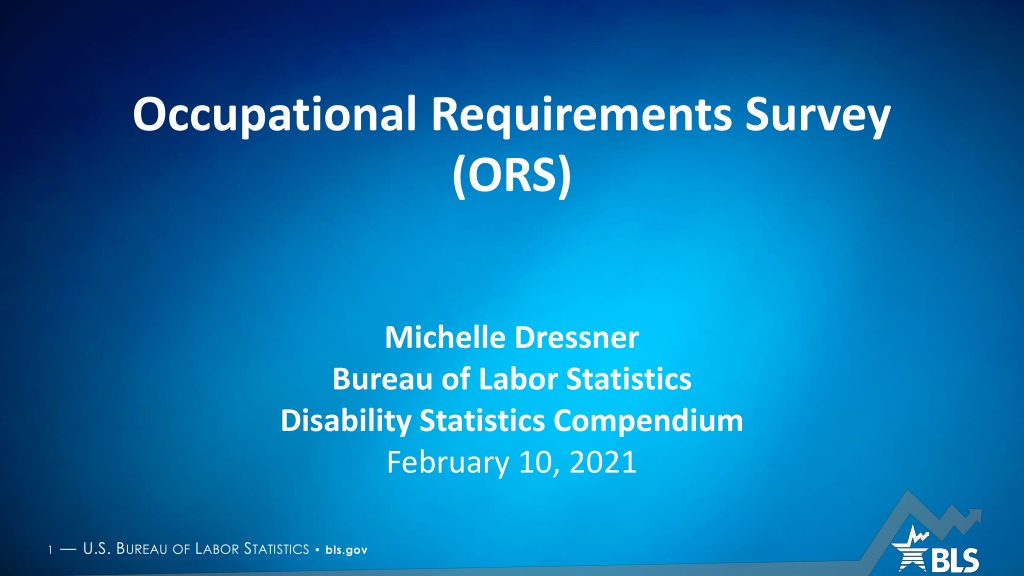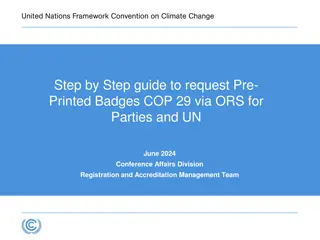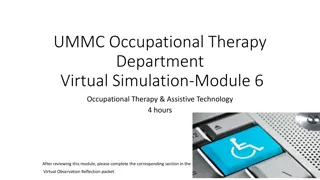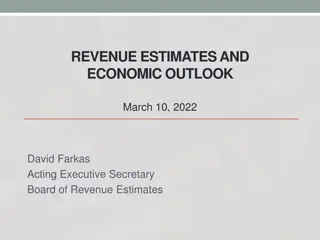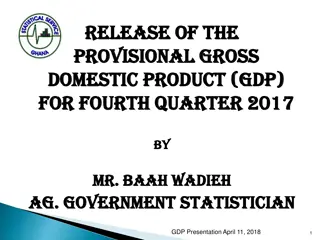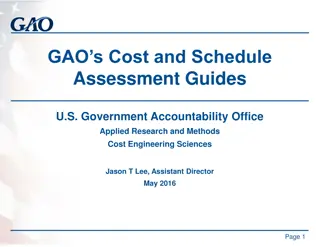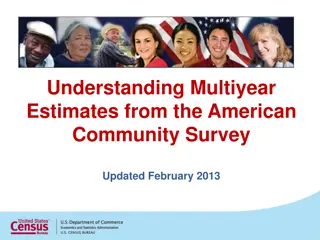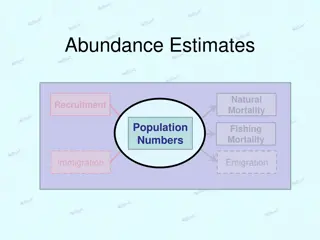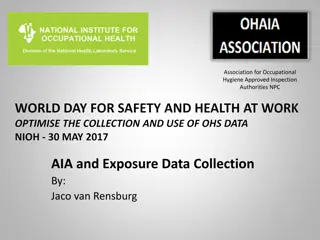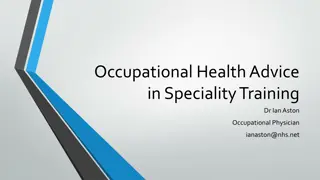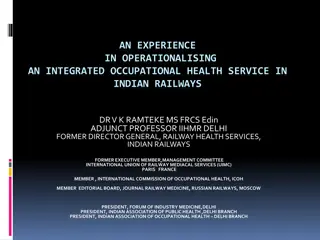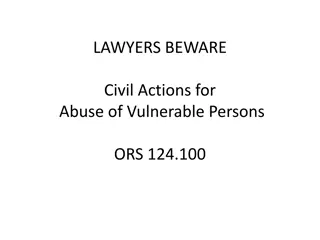Overview of Occupational Requirements Survey (ORS) and 2020 Estimates
The Occupational Requirements Survey (ORS) by the Bureau of Labor Statistics provides detailed insights into the occupational demands of various job roles, including physical, cognitive, and environmental requirements. The survey encompasses data on speaking requirements, weight lifting capabilities, and job classification based on the Standard Occupational Classification (SOC) system. The 2020 estimates cover 20,000 establishments, 35,693 estimates, across 22 occupational groups and 305 detailed occupations.
Download Presentation

Please find below an Image/Link to download the presentation.
The content on the website is provided AS IS for your information and personal use only. It may not be sold, licensed, or shared on other websites without obtaining consent from the author. Download presentation by click this link. If you encounter any issues during the download, it is possible that the publisher has removed the file from their server.
E N D
Presentation Transcript
Occupational Requirements Survey (ORS) Michelle Dressner Bureau of Labor Statistics Disability Statistics Compendium February 10, 2021 1 U.S. BUREAU OF LABOR STATISTICS bls.gov
Objectives Provide background Introduce estimates Physical demands Environmental conditions Education, training, and experience Cognitive and mental requirements Tools and resources 2 U.S. BUREAUOF LABOR STATISTICS bls.gov
Types of Estimates - Percentages Speaking requirement Civilian workers Speaking duration Project management specialists 6.0% 32.1% 67.9% 94.0% Required Not required Occasional speaking Frequent speaking 3 U.S. BUREAUOF LABOR STATISTICS bls.gov
Types of Estimates - Means Mean (average) maximum weight lifted or carried (in pounds) by occupational group, 2020 75 50 25 0 All workers Office and administrative support Management Healthcare practitioners and technical Construction and extraction Installation, maintenance, and repair 4 U.S. BUREAUOF LABOR STATISTICS bls.gov
Types of Estimates - Percentiles Percentile maximum weight lifted or carried (in pounds) for healthcare practitioners and technical occupations, 2020 100 75 50 25 0 10th percentile 25th percentile 50th percentile (median) 75th percentile 90th percentile 5 U.S. BUREAUOF LABOR STATISTICS bls.gov
Survey Scope Includes Private industry State & local government Excludes Federal government & military Agriculture workers Volunteers Self-employed/business owners 6 U.S. BUREAUOF LABOR STATISTICS bls.gov
Classifying Jobs Standard Occupational Classification (SOC) System Allows for comparison Updated to reflect modern jobs Based on job requirements Critical job function Critical tasks 7 U.S. BUREAUOF LABOR STATISTICS bls.gov
2020 Estimates Year 2 of the Second Wave 20,000 Establishments 35,693 Estimates 22 Occupational groups 305 Detailed occupations 8 U.S. BUREAUOF LABOR STATISTICS bls.gov
Job Requirements Physical demands Environmental conditions Cognitive and mental requirements Education, training and experience 9 U.S. BUREAUOF LABOR STATISTICS bls.gov
Physical Demands 10 U.S. BUREAUOF LABOR STATISTICS bls.gov
Strength level required for civilian workers, 2020 Very heavy, 1.3% Heavy, 9.4% Sedentary, 27.4% Medium, 28.4% Light, 33.4% 11 U.S. BUREAUOF LABOR STATISTICS bls.gov
Percentage of workers with strength levels by occupational group, 2020 Production Construction and extraction Transportation and material moving Food preparation and serving related Healthcare support Computer and mathematical Business and financial operations 0.0% 10.0% 20.0% 30.0% 40.0% 50.0% 60.0% 70.0% 80.0% 90.0% Very heavy Heavy Medium Light Sedentary 12 U.S. BUREAUOF LABOR STATISTICS bls.gov
Environmental Conditions 13 U.S. BUREAUOF LABOR STATISTICS bls.gov
Percentage of workers exposed to the outdoors by occupation, 2020 Highway maintenance workers Construction laborers Heavy and tractor-trailer truck drivers Correctional officers and jailers Automotive service technicians and mechanics Personal care aides Welders, cutters, solderers, and brazers Shipping, receiving, and inventory clerks Stockers and order fillers All workers Waiters and waitresses Cooks, restaurant 0.0% 25.0% 50.0% 75.0% 100.0% 14 U.S. BUREAUOF LABOR STATISTICS bls.gov
Education, Training and Experience Specific vocational preparation Formal education Prior work experience On-the-job training Credentials 15 U.S. BUREAUOF LABOR STATISTICS bls.gov
Percentage of workers by minimum education level, 2020 45.0% 40.4% 40.0% 35.0% 29.7% 30.0% 25.0% 18.5% 20.0% 15.0% 10.0% 4.3% 5.0% 2.6% 2.3% 1.4% 0.0% No minimum education High school diploma Associate's vocational degree Associate's degree Bachelor's degree Master's degree Professional degree 16 U.S. BUREAUOF LABOR STATISTICS bls.gov
Cognitive and Mental Requirements Work Review Frequency of work being checked Presence of supervisor Pace Control of workload Work pace Pause control Interactions Working with the general public Working around crowds Telework Problem Solving Personal Contacts Verbal interactions People skills Supervising Others 17 U.S. BUREAUOF LABOR STATISTICS bls.gov
Percentage of workers required to work around crowds by occupational group, 2020 Police and sheriff's patrol officers Firefighters News analysts, reporters, and journalists Emergency medical technicians Correctional officers and jailers Security guards Meeting, convention, and event planners Waiters and waitresses Hosts and hostesses Teaching assistants, special education All workers 0.0% 10.0% 20.0% 30.0% 40.0% 50.0% 60.0% 70.0% 80.0% 90.0% 18 U.S. BUREAUOF LABOR STATISTICS bls.gov
Accessing the Estimates Accessible via www.bls.gov/ors/data.htm Single screen and multi-screen options for data retrieval Excel spreadsheet Occupation profiles for major groups Highlights in The Economics Daily 19 U.S. BUREAUOF LABOR STATISTICS bls.gov
Accessing the Estimates Accessible via www.bls.gov/ors/data.htm Single screen option for data retrieval Text files for all data available 20 U.S. BUREAUOF LABOR STATISTICS bls.gov
Accessing the Estimates: Excel Dataset Accessible via www.bls.gov/ors/additional- publications/publications.htm Excel spreadsheet Contains all estimates 21 U.S. BUREAUOF LABOR STATISTICS bls.gov
Contact Information Occupational Requirements Survey www.bls.gov/ors Michelle Dressner 202-691-6199 orsinfo@bls.gov 22 U.S. BUREAUOF LABOR STATISTICS bls.gov
